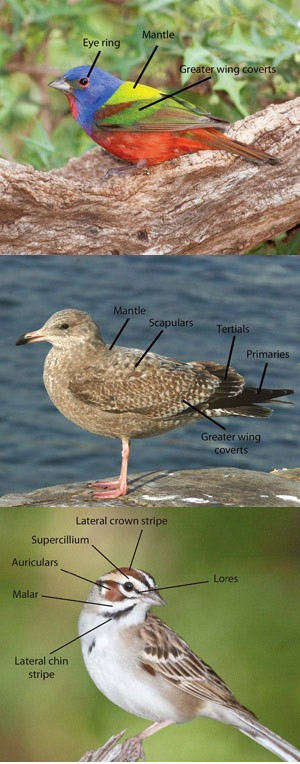A forester cannot properly describe a tree without terms like “crown” and “trunk.” A hunter can’t boast of a champion white-tailed buck without discussing the finer points of its “rack.” And no birdwatcher can describe how birds fly without mentioning their “wings.”
Bird are much more than wings, of course, so here is a lesson on bird morphology, a refresher on the terms you skipped over from the introductory pages of your field guide.
No matter how different they may appear, all birds have descended from a common ancestor. So the warbler and the woodpecker, the eagle and the egret, all share common feathers growing from specific regions on a bird’s body.
Consider the species pictured here: painted bunting, herring gull, and lark sparrow. The gull, in its first-winter plumage, is a terrifying sight to many birdwatchers. That is because many do not know how to look at a gull, how to approach its identity. To the trained eye, though, the groups of feathers on this gull are as distinctive as those on a more obvious bird like the bunting.
The triangle of lemon-lime feathers behind the bunting’s head is the mantle (or upper back). The gull has a similar triangular patch of feathers behind its head, only smaller in this photo. They bleed into a separate patch of feathers on the shoulders, called scapulars, some of which have little black spades in them, extending along the gull’s back. Scapulars are big on gulls and important for identification of immature gulls.
That band of darker green feathers across the bunting’s folded wing make up the greater wing coverts. Coverts are small feathers, often covering the base of larger feathers, such as wing or tail feathers. On the gull, I’ve marked the greater wing coverts. Their appearance is helpful in the identification of many immature gulls.
In the lark sparrow, the median wing coverts are tipped in white. Rows of white-tipped wing coverts give rise to a field mark common to many birds, wing bars. Two wing bars most often arise from white tips to the median and greater wing coverts. That lark sparrow is also a model for markings on a bird’s head. I’ve labeled them accordingly.
My point is not that you must learn these terms right away, but only to recognize that feather groups are like road signs or pavement markings – they’re places we can turn, no matter where we are, to understand unfamiliar terrain, to get our bearings. It is one thing to note merely that a sparrow has light and dark stripes on its head. It is far better to note the dark eye-line and lores, the dark auriculars, the lateral chin stripe and pale malar, the rusty lateral crown stripes, and the pale supercillium.
That kind of detail is your roadmap to the correct identification. Anything less would be like saying a tree has a bunch of green things at the top.


